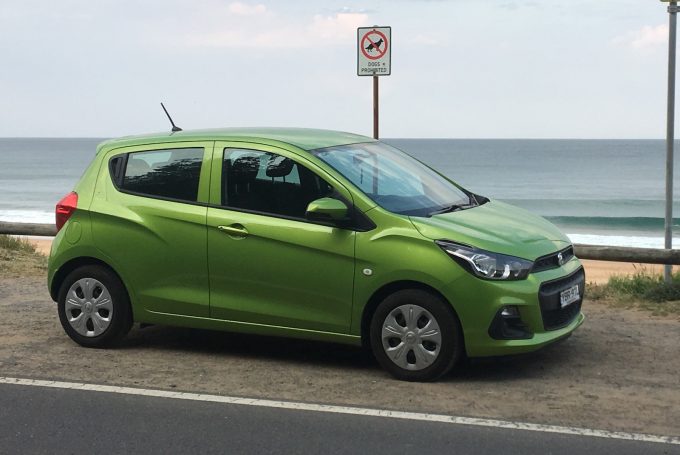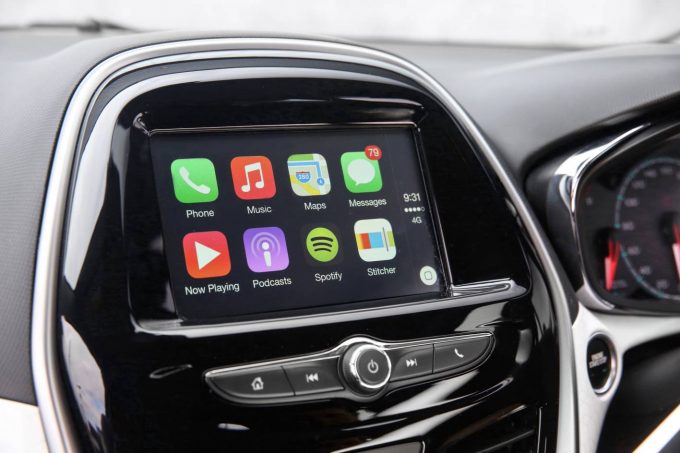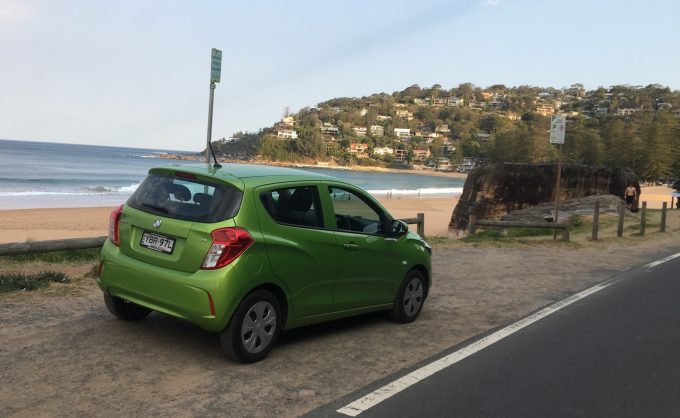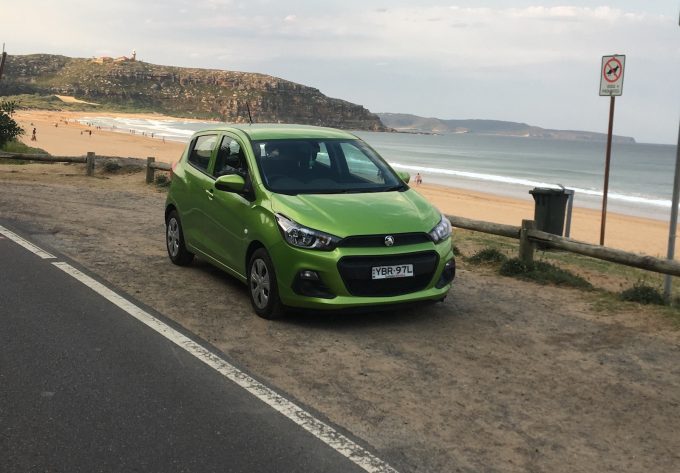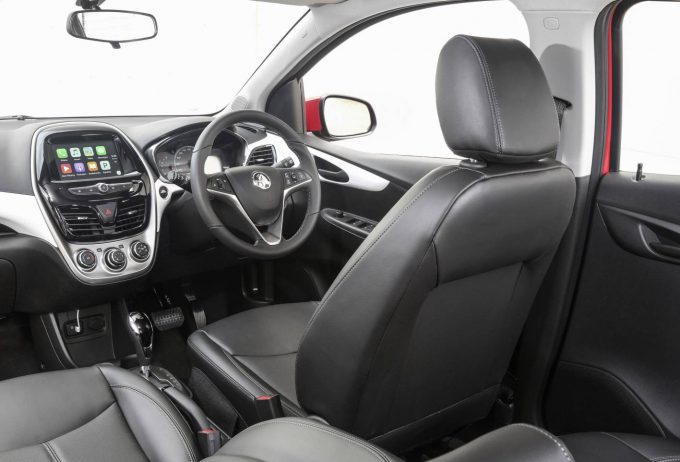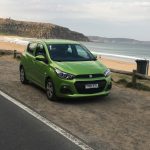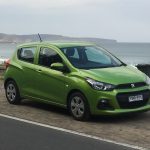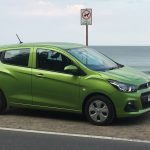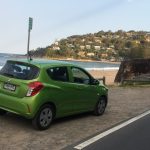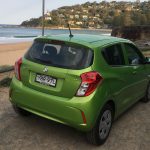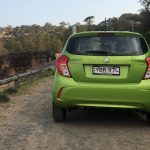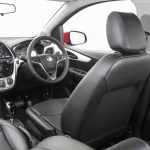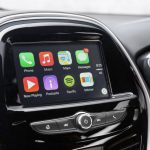The city car class is seemingly shrinking, with a 27.6 per cent year-on-year reduction in sales for the segment compared with 2016 (August 2017 VFACTS). Nevertheless, there are still some strong contenders in the class, with the 2017 Holden Spark accounting for 15.6 per cent of the segment sales. We tested the $15,690 CVT automatic-equipped LS to see how well it meets city car customer needs.
2017 Holden Spark LS: Cabin space and comfort
The Spark is a dinky thing, at 3595mm long, 1595mm wide and 1476mm tall on a wheelbase of 2305mm. Its boot is a diminutive 185L, but that extends to a decent 985L when the seats are folded. Unlike its European relation the Vauxhall Viva, the rear squab doesn’t fold up, so there is a ridge when the seats are folded.
Because of the upright packaging, the outboard seats offer decent room in all directions. The seats are well cushioned and broad, enough to accommodate most body types
2017 Holden Spark LS: Infotainment and ergonomics
This was the focal point of the Spark when launched in early 2016. The 7.0-inch colour touch-screen with Holden MyLink, incorporating Apple CarPlay and Android Auto sits in a piano black fascia, itself enshrouded in a neat aluminium trim insert.
Operating audio controls via the steering wheel buttons, central volume knob or touch-screen is very easy and pleasant. Although arch-rival Kia Picanto now offers a touch-screen with smartphone mirroring as well, it doesn’t look as upmarket or nifty as the Spark. Air con/heater controls are also easy to operate. We wouldn’t mind a digital speedometer in the trip computer, but since no other rival offers this, we won’t complain too much.
2017 Holden Spark LS: Design
The Spark has a confidence and modernity about it that links it to other Mike Simcoe led designs such as recent Commodores. Even the hubcap-laden LS stands out in green (no longer available). Holden’s new colour palate for 2018 includes beige, light blue, black and grey. Although the interior and exterior remain fresh and contemporary, the Spark’s jutting jawline scrapes on almost every driveway and bump it encounters.
2017 Holden Spark LS: Engine and performance
The Spark uses GM’s venerable Family II 1.4-litre DOHC four-cylinder engine, developing 73kW at 6200rpm and 124Nm at a rather peaky 4400rpm. This means it is a zingy top-end performer but not as tractable as rival Kia Picanto, which offers less power from its smaller 1.2-litre engine, but its 122Nm of torque comes in at a lower 4000rpm. The automatic version is more responsive than the insipid manual, which we’ll detail below.
2017 Holden Spark LS: Transmission
The two gearbox choices for the Spark are a five-speed manual or CVT automatic. The former suffers from too tall gearing, which, combined with vague throttle response, makes it difficult to judge the right gear for hills at times.
Spark’s CVT automatic better maximises the available torque and power, without the hesitation and ‘elastic band’ feeling that afflicts many other gearboxes of this type. There is a slight whine to the gearbox at low speed, but you’ll need a keen ear to detect this. It’s behaviour at freeway speeds is fine and it is a far superior companion than the manual in our opinion.
2017 Holden Spark LS: Handling and steering
The steering feel of the Spark is sharp and feelsome, giving it a larger car feel than some of its rivals. It significantly beats the Mirage in this department as well as body control and composure too. The Kia Picanto isn’t too shabby to drive, but maybe lacks the outright edge of the Spark in terms of handling and driver enjoyment. A solid score here.
2017 Holden Spark LS: Ride and NVH
For a small car, the Spark handles bumps with panache, with a substantial, well-damped feel. The suspension is not overly firm, so there is now low-speed crashing common to the segment. Holden have done well here. So to with engine, wind and tyre noise suppression, setting the segment standards.
2017 Holden Spark LS: Fuel economy and running costs
The CVT-equipped version may be quoted at 5.2L/100km, but in the real world, our Spark is relatively thirsty, closer to the 7 mark around town and low 6s on the freeway. This makes short work of the 32L fuel tank and means more trips to the servo than you might expect. This can be attributed to a gearbox that is perhaps optimised to perform better in a lab than the road and a rather old-tech, peaky engine. Not terrible, but definitely not brilliant either. Capped-price servicing and 15,000km intervals does offset this though.
2017 Holden Spark LS: Safety
A full 5 star ANCAP rating for the Spark is a given, thanks to a well-calibrated stability control, six airbags, ISOFIX child restrains and a very rigid structure for a small car. It does miss out on autonomous emergency braking and basic cruise control ( optional, standard on LT), let alone adaptive like the Suzuki Swift GLX in a similar price category.
2017 Holden Spark LS: Value for money
The design elevates the Spark above even the Barina, let alone all its rivals, giving a more upmarket feel than you’d expect of the price. It generally feels like a pretty complete car, but for the omission of cruise control, rear power windows and reverse camera on the standard variant. It is starting to straddle the Barina’s category with its $13,990 entry pricing, rather than the Mirage’s sub $13k pricing, let alone the (now deleted) Suzuki Celerio. The depth of engineering in this car does add to the value equation.
2017 Holden Spark LS: Conclusion
The Spark successfully uses modern design and its colour screen as major drawcards, with low running costs, a user-friendly and surprisingly dynamic and refined drive as unexpected bonuses for the price. With the segment in decline and vehicles like the crossover Suzuki Ignis gaining more traction, perhaps the Spark Activ with its cladding, roof racks and side steps would be a wise addition. We’d also particuarly enjoy an RS turbo version too.

